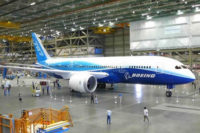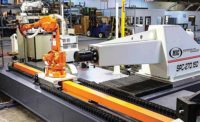Automation Helps Productivity Take off at Boeing
Sophisticated motion control systems ensure safety and productivity on the Dreamliner assembly line.

The three main sections of the 787 fuselage are joined with 14 positioners mounted to transport structures that can move either independently or together. Photo courtesy Siemens Industry Inc.

An indoor GPS provides real-time positioning data for aligning subsections of the jet. Photo courtesy Siemens Industry Inc.

AIT designed the positioning systems so they could be rolled under the aircraft dollies after the fuselage sections are brought into the Boeing factory. This radically reduced the need for auxiliary equipment. Photo courtesy Siemens Industry Inc.

All the actions of each section of AIT’s assembly system are controlled and monitored by Siemens Simotion motion controllers. Photo courtesy Siemens Industry Inc.

Using GPS data points, AIT’s system calculates how much each section (nose, tail, left and right wings) must move to ensure an exact fit with the adjoining section. Photo courtesy Siemens Industry Inc.

The safety concept for the overall system was based upon three principles: increasingly layered safety architectures, greater integration between the control and safety systems, and more use of networking. Photo courtesy Siemens Industry Inc.

This positioner aligns a wing with the fuselage. Photo courtesy Siemens Industry Inc.

By assembling major subassemblies, as opposed to building the plane from the ground up, Boeing can produce a Dreamliner in approximately three days. Photo courtesy Siemens Industry Inc.

This schematic shows the independent, but interconnected, nature of the control platforms for each section of the AIT assembly system. Siemens Scalance wireless technology is used for switching. Illustration courtesy Siemens Industry Inc.









Manually assembling small parts isn’t that difficult. Inserting a screw into a hole or a wire into a connector is simply a matter of hand-eye coordination. Assembling larger parts, like, say, the multiton fuselage sections of a jetliner, is whole other matter. Such a task requires sophisticated motion control hardware and software.
This was the challenge faced a few years ago by Advanced Integration Technology (AIT) when it secured a contract from Boeing to design an automated system to align and assemble the fuselage sections of the 787 Dreamliner.
AIT designs and builds complex, fully integrated manufacturing, tooling and assembly systems for commercial and military aircraft. The company has supplied automation for the world’s leading aerospace OEMs, including Airbus, Bombardier, BAE Systems, Lockheed Martin, Spirit AeroSystems and Vought Aircraft. The 20-year-old company operates six locations in the United States, Canada, Sweden and Spain.
For the Dreamliner project, AIT designed and built the systems needed to align and join the major fuselage sections during final assembly. The company also designed and built the moving assembly line for the jet. The key elements of the system include the motion control system, servo drive platforms, failsafe CPUs and all distributed I/O. The entire system communicates over a Profinet network. In addition, comprehensive safety technology was incorporated into the entire system.
As a prime contractor for the 787 project, AIT provided two complete assembly systems and one positioning system. In AIT’s design, the three main sections of the fuselage are joined with 14 positioners mounted to transport structures that move either independently or are interlocked and indexed to the factory floor for stability. Real-time positioning data are logged with an integrated indoor GPS.
AIT designed the alignment and positioning systems so they could be rolled under the aircraft dollies after the sections are brought into the Boeing factory. This radically reduced the need for auxiliary equipment, material handling and additional positioning steps.
On-site at Boeing, the 14 positioners are moved into their respective locations near the cradle dollies and engaged to lift and move the aircraft sections. Once the positioners are locked in place, the GPS measurement system determines the exact locations of each airplane section. From those data points, the system can calculate how much each section (nose, tail, left and right wings) needs to move to ensure an exact fit with the adjoining section. This precise alignment ensures smooth and rapid assembly of the aircraft.
Control System Implementation
The right control system for the project would be critical. “We looked for a supplier that could offer an off-the-shelf selection of automation and motion control solutions and that could offer us global support,” explains Ed Chalupa, AIT president. “Our goal was to align ourselves with a leading automation technology supplier and to use the latest advances in software, integrated safety and control technology. Both Boeing and AIT were keenly sensitive to life cycle security issues in this critical area of the project.”
In addition, it was vital that the supplier be able to provide comprehensive application engineering support, as well as training on both the hardware and software. The supplier would also need to prototype and demo equipment for both AIT and Boeing.
After reviewing several contenders, AIT chose Siemens control system components.
Large-Scale Motion Control
The basic scheme of the motion control system at Boeing comprises a Simotion D motion controller, a Siemens HMI on a Windows-based PC, a Simatic S7 Safety PLC, and fail-safe standard I/O modules—all running on a Profinet network. This basic architecture was then multiplied by the number of control nodes for each positioner in the overall assembly line.
Each positioner can work independently of the others in the line. Or, with the addition of a few Profinet cables and the right mode selections on each positioner, the entire body assembly system can run as a single entity. When running as a single unit, the safety devices likewise work cooperatively, providing proper response levels to all emergency-stop events on the line. Each positioner’s motion controller receives commands to perform uniform group movements with the system as a whole via network communications from the HMI.
The Siemens Simotion D motion controller governs all axis movements to accurately position and align the airplane sections.
AIT designed the overall layout of the control architecture and programmed the Simotion system with the Simatic S7 PLC, distributed I/O and integrated safety. Boeing did not need to customize the controller hardware or HMI panels.
Staying Safe
The safety concept for the overall system was based upon three principles: increasingly layered safety architectures, greater degrees of integration between the control and safety systems, and more use of networking, especially Industrial Ethernet.
In operation, these principles manifested themselves in the form of physical barriers and mechanical means, such as walls, gates, door interlocks and light curtains, all designed to separate personnel from danger. At the same time, the control systems, including programmable safety relays and safety PLCs, monitor operating conditions within established parameters. Safety shutdown systems, such as automatic shutdown via safety PLC or manual shutdown via emergency stops, offer additional protections.
Siemens engineered a safety protocol that simplified the complexity often encountered in the integration of control and safety systems. This was achieved by reducing the issues related to different programming languages and procedures, installation and configuration requirements, maintenance procedures and human error factors. The result was lower total cost of ownership, owing to a substantial reduction in engineering, hardware, training and spare parts.
With integrated safety and control, the project has a single system for standard and safe automation, with one bus and one engineering system for both standard and safety technology. This further reduced cost. As a collateral benefit, the software allows easier replication of series machines. Likewise, faster troubleshooting and extensive onboard diagnostics reduce downtime and enable faster restarts after issue resolution.
Functionally, integrating safety in the control system allows for uniform user interfaces and data libraries. It also reduces the variety of control cabinets needed for the various applications.
PROFIsafe—the first communication safety profile meeting the IEC 61508 safety requirements—is the backbone of all fail-safe communication. PROFIsafe facilitates the transmission of both standard and safety-related data on a single bus cable, using either Ethernet or fieldbus protocol. With advanced PLC and Industrial Ethernet networking technologies combined, the system safety became a production asset that protects the workers while ensuring maximum availability and uptime. Reductions in initial capital expense and field operating expense were also realized.
ASSEMBLY ONLINE
For more information on aerospace automation, visit www.assemblymag.com to read these articles:
Looking for a reprint of this article?
From high-res PDFs to custom plaques, order your copy today!















